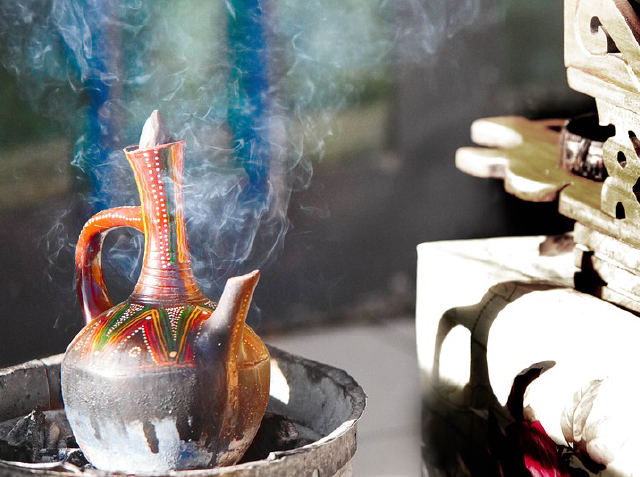What are the characteristics of Ethiopian coffee? Common coffee beans

Professional coffee knowledge exchange more coffee bean information please follow the coffee workshop (Wechat official account cafe_style)
Qianjie-introduction of Ethiopian Coffee and Common Coffee varieties
Ethiopia has unique natural conditions suitable for growing all imaginable varieties of coffee. As a upland crop, Ethiopian coffee beans are mainly grown in areas between 1100 and 2300 meters above sea level, roughly distributed in southern Ethiopia.
Deep soil, well-drained soil, weakly acidic soil, red soil and soft loam soil are suitable for growing coffee beans because these soils are nutritious and humic. Precipitation is evenly distributed during the seven-month rainy season; during the plant growth cycle, fruits blossom to fruit and crops grow by 90-2700 mm per year, while temperatures fluctuate between 15 and 24 degrees Celsius throughout the growth cycle.
Ethiopia is the hometown of Arabica coffee, and it is in the forests of Kaffa that you can see wild Arabica coffee. In Ethiopian, coffee is called "Bun" or "Buna". Coffee beans (coffeebean) may be translated from "Kaffa Bun". Arabica coffee has long been found in the Harald area, probably from the Kafa forest.
Essel coffee is processed by two processing methods: sun and water washing. The flavor of coffee processed by different processing methods is very different. Generally speaking, the alcohol thickness and soil taste of washed Sidamo, Yirgacheffe and Limmu coffee are slightly lower, and the taste of sun-processed coffee is more wild. But Essex coffee may taste different from batch to batch, which requires more cup tests in order to find really good coffee.
There are four main coffee trees in the world, of which only two are of real commercial value and are planted in large quantities, and the quality of the coffee beans produced by other coffee trees is also higher than that of other coffee trees. The first is Arabica beans, the second is Robasta, and the other two are Liberian and Esselsa.
If the variety of coffee is divided by biology, it can be divided into Arabica, Robusta and Liberica.
Tibica (Typica)
Tibika is the first commercial variety to be taken away from the Arabian Peninsula and its origin is an unknown place in Yemen. It was introduced from Ethiopia in the mid-15th century and evolved in this place. And then taken to India. The Dutch brought Tibica to Java at the end of the 17th century, and then Indonesia introduced it. And eventually grow it all over the world.
Morphologically, Tibica is conical in shape, with narrow leaves and slender fruits and seeds. Although some list the Jamaican Blue Mountains as a unique species, they belong to the same species genetically.
Bourbon (Bourbon)
Bourbon is the second variety to be cultivated around the world after Tibika, which also originated in Yemen. The early French introduced Yemeni coffee, a local variety, to the then island of Bourbon, which is now called Reunion. It was first planted in Brazil in 1859 and soon spread around the world. The benefit is higher than Tibica. Now the famous Brazilian yellow bourbon is also mutated from this breed.
The original red bourbon gradually replaced Tibica in Central America because of its higher benefits than Tibica. Later, French missionaries brought Bourbon to Tanzania and gradually spread throughout East Africa.
The bourbon tree is more round than iron, it has wider leaves and its fruit is more round.
Rose summer (geisha)
Rosa originated somewhere near the village of Banchimaji Rosha in Ethiopia. In 1931, the British picked and transported them to Kenya from the forests around Kafa. In 1936 the seeds were transported to Uganda and Tanzania.
In 1953, seeds were planted and studied by the Centre for Tropical Agricultural Research and higher Education (CATIE) in Costa Rica, and shortly thereafter in Panama. Because of low productivity and poor quality, most places give up planting. The Panama award-winning rose variety in 2004 came from this sample. As a result, the rose summer variety is famous in the world, and this variety is also known as Panama rose summer. (more varieties are not written in detail)
Knowledge gifts: generally speaking, Arabica is mainly used in single or boutique coffee, while Robusta is used to make instant coffee. Although Arabica can be defined as premium coffee and Robusta as secondary, it does not have to be classified in this way, and it is more appropriate to distinguish it according to its own favorite taste.
END
Important Notice :
前街咖啡 FrontStreet Coffee has moved to new addredd:
FrontStreet Coffee Address: 315,Donghua East Road,GuangZhou
Tel:020 38364473
- Prev

Origami origami filter cup usage origami filter cup coffee brewing origami filter cup coffee formula
Professional coffee knowledge exchange more coffee bean information please follow the coffee workshop (Wechat official account cafe_style) origami filter cup formula (production: 170-180g) Coffee: 15g water: 270g (88-90 ℃) 1. In the first 30 seconds, pour in 40 grams of water. Slowly pour in 130 grams of water for the next 30 seconds. Pour 270 grams of water 80 seconds before the timer arrives.
- Next

Classification and Flavor characteristics of Ethiopian Coffee Bean Heirloom varieties introduced in Ethiopian Fine Coffee producing areas
Ethiopia, the birthplace of coffee, has a number of boutique coffee producing areas, producing popular high-quality coffee beans, such as Yega Xuefei, Guoding Ding Ding, Sakui and so on. Each producing area will have its own flavor characteristics. Follow Qianjie Coffee to learn about it.
Related
- Beginners will see the "Coffee pull flower" guide!
- What is the difference between ice blog purified milk and ordinary milk coffee?
- Why is the Philippines the largest producer of crops in Liberia?
- For coffee extraction, should the fine powder be retained?
- How does extracted espresso fill pressed powder? How much strength does it take to press the powder?
- How to make jasmine cold extract coffee? Is the jasmine + latte good?
- Will this little toy really make the coffee taste better? How does Lily Drip affect coffee extraction?
- Will the action of slapping the filter cup also affect coffee extraction?
- What's the difference between powder-to-water ratio and powder-to-liquid ratio?
- What is the Ethiopian local species? What does it have to do with Heirloom native species?

